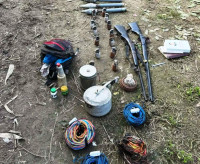National
Group removes 24,575 kg of plastic waste from Sunkoshi River
The cleanup campaign aims to rekindle the culture of accountability and awareness of rivers' heritage and cultural importance among youths.
Post Report
Scores of people from all walks of life came together to clean up the Sunkoshi river on Friday, removing as many as 24,575 kg of waste from the riverside.
The group included a total of 134 individuals—representatives from government agencies, security forces, non-government organisations, and youths and environment activists, among others.
Center for Research and Sustainable Development Nepal (CREASION) led the collaborative effort—under the banner of Sunkoshi River Cleanup Campaign—in partnership with Golanjor Rural Municipality in Sindhuli and various other agencies.
The campaign is part of the Project CAP (Collaborative Approach for Preventing Plastic Leakages in Rivers) under the PLEASE (Plastic Free Rivers and Seas of South Asia) initiative.
The team, which gathered in Khurkot of Golanjor-7, began a series of river cleanup activities to tackle the plastic waste crisis, Ujjwal Upadhyay, project CAP team lead, said. This initiative is crucial, as it requires coordinated efforts across the seven municipalities that have partnered with the project, he said.
The collected waste was transported to a proposed landfill site using specialised equipment.
Aanand Mishra, founder and president of CREASION, stressed the importance of individual accountability in conserving natural resources, emphasising that such initiatives should stem from motivation for a sustainable future.
Shankar Baral, the chairperson of Golanjor Rural Municipality, shared that the pollution in the river bank is mainly caused by plastic bottles and plastic waste thrown by commuters and travellers.
“Major cause of the pollution here in the village is external, not internal,” Baral said. “Looking at the pollution in the river bank, I am afraid the young generation will only associate rivers with plastic—and the heritage of rivers will be drowned by plastic pollution.”
Baral added that although the cleanup campaign is not a permanent solution to plastic pollution, it can at least rekindle the culture of accountability and awareness of rivers' heritage and cultural importance among people.
Baral further emphasised the need to instill a sense of reverence for rivers among the younger generation, ensuring that they view rivers as more than mere dumping grounds for plastic waste.




 8.12°C Kathmandu
8.12°C Kathmandu

%20(1).jpg&w=200&height=120)












